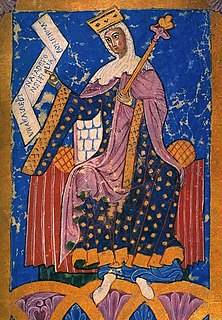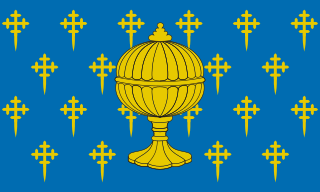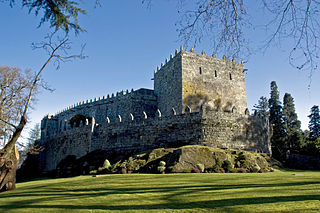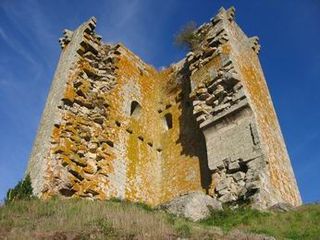
Galicia is an autonomous community of Spain and historic nationality under Spanish law. Located in the northwest Iberian Peninsula, it includes the provinces of A Coruña, Lugo, Ourense and Pontevedra.

Urraca called the Bold, was Queen of León, Castile, and Galicia from 1109 until her death. She claimed the imperial title as suo jure Empress of All Spain and Empress of All Galicia.

Andrade is a surname of Galician origin, which emerged in the 12th century as the family name of the knights and lords of the small parish of San Martiño de Andrade, in the municipality of Pontedeume. The first mention of this small territory is to be found in the documentation of the monastery of San Xoán de Caaveiro, and belong chronologically to the 9th century. It was part of the region of Pruzos, which was created as an administrative and ecclesiastical territory of Kingdom of Galicia in the sixth century by King Teodomiro through a document written in Latin called Parrochiale suevum, Parochiale suevorum or Theodomiri Divisio. From the 12th century Pruzos, and therefore Andrade, were integrated into the county of Trastámara that belonged to the lineage Traba, the most powerful Galician family. By this same time the family group: Fortúnez, begins to unite their names Andrade as surname, since in this parish their family home was located. The knights of Andrade were faithful vassals of their lords the Counts of Trastámara throughout the middle centuries of the Middle Ages.

The Kingdom of Galicia was a political entity located in southwestern Europe, which at its territorial zenith occupied the entire northwest of the Iberian Peninsula. It was founded by the Suebic king Hermeric in 409, with its capital established in Braga. It was the first kingdom that officially adopted Catholicism. In 449, it minted its own currency. In 585, it became a part of the Visigothic Kingdom. In the 8th century, Galicia became a part of the newly founded Christian Kingdom of Asturias, which later became the Kingdom of León, while occasionally achieving independence under the authority of its own kings. Compostela became the capital of Galicia in the 11th century, while the independence of Portugal (1128) determined its southern boundary. The accession of Castilian King Ferdinand III to the Leonese kingdom in 1230 brought Galicia under the control of the Crown of Castile.

The Metropolitan Archdiocese of Compostela, is the senior of the five districts in which the Catholic Church divides Galicia in North-western Spain.

Melide is a municipality in the province of A Coruña in the autonomous region of Galicia in northwest Spain. It belongs to the comarca of Terra de Melide. It has an area of 101 km2 and a population of 9,000 inhabitants mostly spread among its 26 parishes. It has an elevation of 456 meters.

Araújo or Araujo or Arauxo is a Galician and Portuguese surname. The surname Araújo is of toponymic origin derived from a place in the Province of Ourense which is part of the Autonomous Community of Galicia in North Western Spain next to the Portuguese border where a Crusader Knight of French Noble descent, Don Rodrigo Anes, was rewarded with reconquered Iberian lands during the Reconquista. Don Rodrigo Anes de Araújo lived in the 14th century during the reign of King Ferdinand I of Portugal (1367-1383). Don Rodrigo Anes de Araújo built a Castle and named it Araújo which can be found in all the ancient Galician maps.

Alonso III Fonseca was a Galician archbishop and politician. He was archbishop of Santiago de Compostela from 1507, and archbishop of Toledo from 1523. He was a major supporter of the University of Santiago de Compostela. He was the son of the archbishop Alonso II Fonseca and Alonso II's concubine María de Ulloa.

Benigno Álvares. Leader and founder of Galician Communist Party, Galician antifascist activist and partisan against Francisco Franco. This veterinary surgeon became provincial secretary of the Communist Party of Spain (PCE) in Ourense (Galicia) and president of the Provincial Peasant Federation, throughout the Second Spanish Republic. After the military coup in 1936 and the overthrow of Galicia by the franquist domain, he was haunted until his death by the local fascists, in 1937. His corpse was then shown by Civil Guard, tied to a truck, with a sign saying "Here's the Maceda's veterinary surgeon. Communism has died in Ourense".

Pedro Álvarez de Soutomaior, popularly known as Pedro Madruga, was the Count of Caminha and an example of the typical European feudal knight. He gained his nickname, "Madruga" because he was an "early riser". He was a major political player in the Kingdom of Galicia, as well as spending time in the courts of Castile and Portugal. He was one of the leading figures who suppressed the Irmandiño peasant revolt in Galicia in the 1460s, and he was also involved in the War of the Castilian Succession after the death of Henry IV in 1474.

The Irmandiño revolts were two revolts that took place in the 15th-century Kingdom of Galicia against attempts by the regional nobility to maintain their rights over the peasantry and bourgeoisie. The revolts were also part of the larger phenomenon of popular revolts in late medieval Europe caused by the general economic and demographic crises in Europe during the 14th and 15th centuries. Similar rebellions broke out in the Hispanic Kingdoms, including the War of the Remences in Catalonia and the foráneo revolts in the Balearic Islands.

Arias Pérez or Peres was a Galician knight and military leader in the Kingdom of León. According to modern scholar Richard Fletcher, he was "active, resourceful, spirited and persuasive", and the contemporary Historia compostellana says that he was "so eloquent that he could turn black into white and white into black", although he "was not of the great nobility".
Munio or Muño Peláez was a Galician magnate, a member of the Banu Gómez clan, during the reigns of Alfonso VI, Urraca and Alfonso VII. By December 1108 he held the title of comes (count), the highest in the kingdom. He was a son of count Pelayo Gómez, grandson son of Gómez Díaz de Carrión and Teresa Peláez. His mother was Elvira Muñoz, half-sister of count Rodrigo Muñoz, and daughter of Munio Rodríguez and Ilduara Velázquez. Elvira's ancestors had founded the monastery of Santa María de Ferreira.

Pedro Fróilaz de Traba was the most powerful secular magnate in the Kingdom of Galicia during the first quarter of the twelfth century. According to the Historia compostelana, he was "spirited ... warlike ... of great power ... a man who feared God and hated iniquity," for Diego Gelmírez himself had "fed him, like a spiritual son, with the nutriment of holy teaching." Brought up at the court of the Emperor Alfonso VI, Pedro raised the future Emperor Alfonso VII in his household. Around the latter he and Diego formed a "Galician party" that dominated that region during the turbulent reign of Urraca (1109–26). In September 1111 they even had the child Alfonso crowned king at Santiago de Compostela, but it was Pedro who was imperator in orbe Galletiae.

Fernán Pérez de Andrade or Fernán Peres d'Andrade was a Galician knight. His birthdate is unknown but is presumably before 1330. His death date fell between July 28 and August 21, 1397. The fourth son of Ruy Freyre de Andrade and Inés Rodriguez de Sotomayor, he belonged to a family associated with the knights of the Orden de la Banda since its founding by Alfonso XI of Castile in 1332. He was married to Sancha Rodríguez, daughter of Aras Pardo and Tareyga Affonso, and with whom he was known to have had two daughters, Maria and Inés Fernández, nuns of the Order of Saint Clare, and a son who died at an early age, leaving the family without a direct male heir.
Fernando Yáñez was a minor Galician nobleman—a miles, or mere knight—who rose in rank in the service of Queen Urraca (1109–26) and King Alfonso VII (1126–57). He eventually became the royal military commander charged with the defence of the Limia on the border between Galicia and Portugal. Contemporary sources call him the "prince" and "duke" of Limia.

Events in the year 1891 in Brazil.















